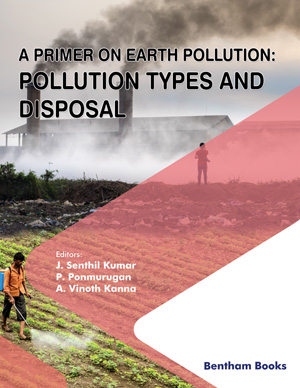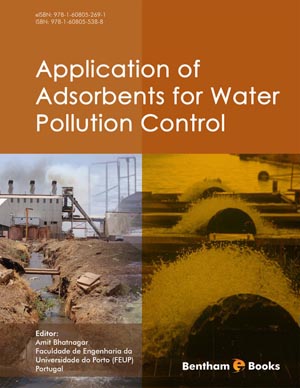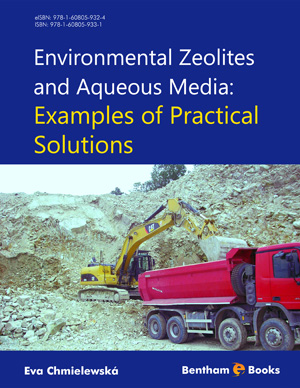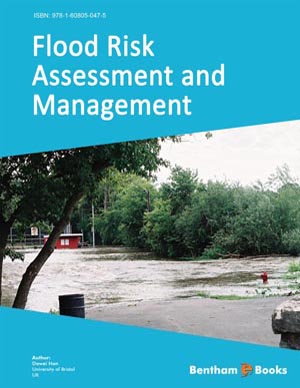Preface
Page: i-ii (2)
Author: Neha Agarwal, Vijendra Singh Solanki and Sreekantha B. Jonnalagadda
DOI: 10.2174/9789815238969124010001
Acknowledgements
Page: iii-iii (1)
Author: Neha Agarwal, Vijendra Singh Solanki and Sreekantha B. Jonnalagadda
DOI: 10.2174/9789815238969124010002
Emerging Pollutants in Aquatic Environment: Critical Risk Assessment and Treatment Options
Page: 1-18 (18)
Author: Neha Agarwal*, Vijendra Singh Solanki, Sreekantha B. Jonnalagadda, Keshav Lalit Ameta, Neetu Singh, Anupma Singh and Vimala Bind
DOI: 10.2174/9789815238969124010004
PDF Price: $15
Abstract
The chemical compounds that have been identified as dangerous to the
environment, ecosystem and human health are classified as Emerging Pollutants (EPs).
EPs include a variety of compounds such as dyes, pesticides, antibiotics, drugs,
endocrine disruptors, hormones, industrial wastes and chemicals, and microplastics.
These pollutants are malignant and non-biodegradable in nature, so they are
responsible for the unhealthy and unsustainable environment. The occurrence of these
pollutants has raised global concerns not only in various environmental matrices (air,
water, and soil) but also in biological systems due to their toxic nature. These
pollutants get accumulated in the environment and ecosystem and cause intensified
environmental problems, global warming, deterioration of soil quality, the greenhouse
effect, and ecological imbalance. Consequently, they affect the quality of life and the
maintenance of the environment on a global level. Recent research indicates that if this
trend is continued, situations will worsen in the near future. Sustainable solutions, such
as bioremediation, nano-bioremediation, microbial degradation etc., are becoming
increasingly important for the removal of these EPs as an efficient tool for sustainable
development and pollution control. Therefore, the main aim of this chapter is to assess
the current threats and future challenges associated with emerging pollutants so that
focus can be drawn on sustainable green solutions for a greener and healthier
environment.
A Critical Review of Microbial Potential for Biodegradation Mechanism of Organic Pollutants
Page: 19-43 (25)
Author: Amrit K. Mitra*
DOI: 10.2174/9789815238969124010005
PDF Price: $15
Abstract
The rise in environmental pollution is a major issue of concern in the current
times. Due to globalization and the Industrial Revolution in the 20th century, pollution
has become a problem for the world's population. Numerous factors, including
unchecked human activity, careless use of petroleum products, industrial waste
emissions, poor waste management, release of toxic organic by-products, and increased
use of pesticides, insecticides and fertilizers have contributed to increased pollution and
its detrimental effects on the planet Earth. For all forms of life, organic molecules are
known to have the potential to be carcinogenic and poisonous. To reduce organic
pollutants and dispose of industrial waste properly, several techniques have been put
forth and put into action, but some of them are either not relevant or have not produced
the expected outcomes. For the past few decades, research has been focused on finding
biological methods of degradation of complex organic contaminants. Numerous
microbial species obtained from polluted native environments have been shown to
digest hazardous, complex organic chemicals and can be used to effectively biodegrade
contaminated areas. The development of recombinant DNA technologies has
revitalized the area of bioremediation by enabling the emergence of microorganisms
and entire microbial communities that contain novel genes and enzymes with improved
efficiencies. This chapter discusses the significance of isolating efficient indigenous
microbial species, different factors that affect the distribution of pollutants in the soil
matrix, biodegradation pathways, and physiological factors that affect the efficiency of
biodegradation for complete mineralization. In addition to these, efforts to enhance the
biodegradation potential of microbes through multiple pathways have also been
highlighted.
A Study of Green Synthesis of Metal Nanoparticles using Plant Extracts and their Biological and Environmental Applications
Page: 44-64 (21)
Author: Sankara Rao Miditana* and Saivenkatesh Korlam
DOI: 10.2174/9789815238969124010006
PDF Price: $15
Abstract
Nanomaterials (NMs)-based technology is a powerful tool in the current
scenario because of their size and unique physicochemical properties. Green
synthesized NMs are promising in creating new and vital products that are beneficial to
the environment, industry, and humans. Due to its simplicity, nontoxicity, and
environmentally benign advantages, the synthesis of metal nanoparticles (NPs) using
green techniques has received a lot of attention recently. Every day, attention is drawn
to recycling waste and putting it to good use. NPs are easily manufactured in a green,
energy-free manner using plant extracts that are not intended for human consumption.
Metal-based NPs are widely used due to their applications, including medicine,
biomedical sciences, biosensing, food, cosmetics, and electronics. NPs produced from
novel synthesis techniques using plant extracts have remarkable qualities. In the
synthesis of NPs via the green approach, many metals such as silver, gold, copper, zinc,
manganese, nickel, and magnesium are used due to their unique physical and optical
properties. In this chapter, the authors have reported the mechanisms of various green
methods of synthesis of NPs, their biological and environmental applications along
with their challenges and prospects.
Current Trends in Green Bioremediation of Environmental Organic Pollutants
Page: 65-95 (31)
Author: Amrit K. Mitra*
DOI: 10.2174/9789815238969124010007
PDF Price: $15
Abstract
A biological process termed bioremediation transforms waste into a form
that can be used and reused by other microbes. Recent research has revealed that
xenobiotic pollution and other associated refractory substances pose a serious threat to
both human health and the environment. Many contaminants, including heavy metals,
polychlorinated biphenyls, plastics and different agrochemicals, are prevalent in the
environment because of their toxicity and inability to biodegrade. The key objective of
bioremediation is the degradation of pollutants and their transformation into less
harmful forms. Depending on several variables like cost, kind and concentration of the
contaminant and other considerations, ex-situ or in-situ bioremediation may be used.
Bioremediation can be done with the help of microorganisms that can withstand all
circumstances due to their metabolic potential. Microbes have a tremendous nutritional
capacity, making them useful in the bioremediation of environmental contaminants.
With the complete and coordinated activity of microorganisms, bioremediation is
significantly involved with the decomposition, expulsion, immobility or
decontamination of different chemical pollutants and physically dangerous chemicals
from the natural atmosphere. Enzymatic processes and other techniques, including
bioventing, bioaugmentation, biostimulation, biopiles and bioattenuation, are widely
used throughout the world based on their characteristics, benefits and drawbacks. This
chapter aims to portray the current advancements in green bioremediation methods,
how various contaminants are broken down by microorganisms and what the future
holds for bioremediation in terms of lowering global pollution levels.
Carbon Dots and their Environmental Applications
Page: 96-114 (19)
Author: N. Maurya, S. Mishra* and M. K. Gupta
DOI: 10.2174/9789815238969124010008
PDF Price: $15
Abstract
CDs (Carbon dots) are a new group of zero-dimensional luminescent
nanomaterials. They have drawn a lot of attention due to their excellent properties, for
example, easy preparation, strong optical properties, low toxicity, significant
biocompatibility, low cost, facile functionalization, tunable porous structures and high
specific surface area. CDs have found many applications in the fields of bioimaging,
sensing, catalysis, optoelectronics and energy conversion. Recently, CDs have
demonstrated promising applications in the control of environmental pollution and
remediation. CDs have been applied for environmental pollutants sensing, adsorption
of contaminants, membrane-based separation, photocatalytic degradation of pollutants,
and antimicrobial coatings for protection. In this chapter, we have discussed the
classification of CDs, synthesis, properties and applications of CDs in environmental
pollution control and environmental protection measures.
Green Synthesized Nanoparticles and Different Domains of their Applications
Page: 115-129 (15)
Author: Nakul Kumar, Pankaj Kumar*, Snigdha Singh, Virendra Kumar Yadav, Deepankshi Shah, Mohd. Tariq, Ramesh Kumar and Sunil Soni
DOI: 10.2174/9789815238969124010009
PDF Price: $15
Abstract
Science has undergone a revolution with the development of
nanotechnology. The vast applications of nanoparticles (NPs) have greatly helped
every area of technology. Nanomaterials (NMs) can be created via a range of physical
and chemical practices along with the use of ultrasound and microwave heating
processes, but green synthesis has drawn great attention, especially when it involves
the use of microbes or plant extracts. Green synthesis is a recent and advanced method
to make NPs because it is simpler, cheaper, more reproducible and environmentally
friendly than other approaches. When compared to other classical methods of NP
synthesis, plants produce NPs that are more stable and simpler to scale up and have a
variety of applications. This chapter has reviewed and discussed various applications of
green synthesized NPs along with the latest developments in the eco-friendly synthesis
of gold, silver, copper, palladium, iron, and iron oxide NPs. Due to the widespread use
of nanoscale metals in different industries, including engineering, medicine, and the
environment, the topic of nanoscale metal synthesis is currently relevant. The bulk of
nanoscale metals is currently produced chemically, which has unintended effects like
environmental contamination and serious health issues. To overcome these challenges,
green synthesis can be used as a commercial chemical method to decrease metal ions
from the environment. Green synthesis is more advantageous than classical chemical
synthesis because it improves environmental quality and is also safe for human health.
Efficiency and Applications of Nanoparticles Synthesized from Microalgae: A Green Solution
Page: 130-150 (21)
Author: Saivenkatesh Korlam*, Sankara Rao Miditana and S. Padmavathi
DOI: 10.2174/9789815238969124010010
PDF Price: $15
Abstract
Nanotechnology has gained significant attention in the fields of
biotechnology and biomedicine and has been widely used in drug delivery, imaging,
diagnosis, and sensing. Nanoparticles (NPs) are submicron-sized particles that have
unique properties due to their high surface area-to-volume ratio. NPs have gained
significant attention in recent years due to their potential applications in biotechnology
and biomedicine, including drug delivery, imaging, diagnosis, and sensing. Microalgae
are photosynthetic microorganisms that are widely distributed in aquatic environments.
Recently, microalgae have been explored as a potential source of NPs due to their
unique chemical and physical properties. Microalgae-derived NPs have several
advantages over chemically synthesized NPs, including lower toxicity,
biocompatibility, and eco-friendliness. In this chapter, we have discussed the various
types of NPs produced by microalgae, their synthesis and characterization methods,
and their different domains of applications, with a special focus on environmental
remediation. Additionally, we have highlighted the challenges and prospects of using
microalgae-derived NPs.
Application of Green Synthesized Nanomaterials for Environmental Waste Remediation: A Nano-Bioremediation Strategy
Page: 151-181 (31)
Author: M. Nanda, S. Agrawal and S. K. Shahi*
DOI: 10.2174/9789815238969124010011
PDF Price: $15
Abstract
In the current scenario, dangerous refractory organic and inorganic
pollutants are continuously released into the environment as a result of industrialization
that poses a significant threat on a global scale. One of the greatest challenges that
needs to be solved is the effective management of various pollutants and waste. Despite
their effectiveness, traditional treatment methods have several drawbacks, such as the
fact that they are time-consuming and target-specific. As a result, it directs the search
for a suitable replacement. Researchers are paying close attention to the novel
technique of nano-bioremediation to remove pollutants from various contaminated
locations. This approach combines the benefits of bioremediation and nanotechnology
to develop a remediation process that is quicker, more productive, and less harmful to
the environment than either approach individually. This chapter summarizes the green
synthesis methods of various nanomaterials (NMs) along with an explanation of the
remediation methodology, its mechanism, and prospective applications in
environmental remediation. Additionally, the removal and valorzsation of waste
materials using green nanotechnology supported by microbes and enzymes are
highlighted. This chapter also discusses the multiple constraints of nanobioremediation as well as the factors responsible for the efficiency of NMs.
Phytoremediation/Phytoextraction: A Sustainable Approach to the Restoration of ChromiumContaminated Soil
Page: 182-207 (26)
Author: Pankaj Kumar*, Deepankshi Shah, Manoj Kumar, Snigdha Singh, Virendra Kumar Yadav, Mohd. Tariq, Ramesh Kumar, Nakul Kumar, Shivraj Gangadhar Wanale and Shipra Choudhary
DOI: 10.2174/9789815238969124010012
PDF Price: $15
Abstract
Chromium is a major component that is responsible for environmental
stress. It also has profound effects on the health of living beings because trace amounts
of chromium in the environment have been linked to serious health problems in
humans and plants. The dangers to human health, bioavailability, plant response to
chromium toxicity, and phytoextraction storage in plants are issues of major concern.
Understanding and optimizing the phytoextraction process would be immensely
beneficial to know about metabolic pool changes that occur in plants in response to Cr
toxicity. Therefore, the removal of chromium from the environment is necessary due to
its toxic nature. However, the removal of chromium from the environment is a daunting
task. Physico-chemical and biological techniques are either too expensive or inefficient
to be widely implemented to eradicate chromium from the contaminated soil and
environment. The challenges of widespread implementation can be met by adopting integrated approaches, which are currently under consideration. The removal of
chromium from the environment can be more economical and sustainable using
phytoremediation technology.
In this chapter, we have discussed the phytoremediation technique as a green solution
for the removal of chromium from polluted soil because phytoremediation, and
especially phytoextraction, is a viable and sustainable solution to restore chromiumpolluted soil.
Significance of Nanobioremediation for the Removal of Contaminants from Water: Challenges and Future Prospects
Page: 208-228 (21)
Author: Shraddha Bais* and Ruchi Shrivastava
DOI: 10.2174/9789815238969124010013
PDF Price: $15
Abstract
Water is the most crucial natural resource required for the survival of
humankind, but chemical industries, household activities, foul practices, etc., are
responsible for polluting it. This leads us to work on the purification and
bioremediation of water contaminants. Diverse techniques have been developed
globally for decontamination/purification of water, but owing to their high cost,
tediousness and time consumption, it has become necessary to work on those methods
that are comparatively cheaper, techno-feasible and employ a green process. In the
contemporary world, the use of nanotechnology in the bioremediation of water
pollutants revolutionarily provides a way to incorporate functional chemicals in notably
reduced quantities to fulfil the desired purpose. Globally, water pollution is primarily
caused by the rainwater containing the pollutants present in the air. Industrial and
domestic wastewater, which is a major source of toxic heavy metals, industrial dyes,
pesticides and insecticides, is used in agriculture. These water pollutants adversely
affect the health of human beings as well as the whole ecosystem of the affected
region. The employment of nano-materials (NMs) degrades the pollutants from the
water source to its standard permissible level. The current chapter comprises a detailed
discussion on the immense potential of NMs in the bioremediation of polluted water
using different NMs and also provides a comprehensive comparison with other
conventional bioremediation methods to make water environmentally non-hazardous.
Current Trends in Biogenic Synthesis and Applications of Palladium Nanoparticles: A Sustainable Approach to Environmental Remediation
Page: 229-248 (20)
Author: Gitanjali Arora, Anamika Srivastava*, Manish Srivastava, Jaya Dwivedi, Shruti and Rajendra
DOI: 10.2174/9789815238969124010014
PDF Price: $15
Abstract
Nanotechnology is a multidisciplinary area with a wide range of
applications. Recent developments in nanotechnology and nanoscience have also
triggered the development of new nanomaterials (NMs), enhancing the hazards to
human health and the environment. There has been a rise in interest in creating
ecologically friendly techniques for producing metallic nanoparticles (MNPs). The aim
is to reduce the harmful effects of synthetic technologies, the chemicals used in
association with them, and the derivative products. A useful strategy in green
nanotechnology is the utilization of various biomolecules for the fabrication of NPs.
MNPs that are inexpensive, energy-efficient, nontoxic, and beneficial to the
environment have been produced using biological resources, including bacteria, algae,
fungi, and plants. Plant components are mainly employed as capping and reducing
agents in green synthesis. MNPs of various sizes and forms have been created using
bark, leaves, fruits, and flower extracts. In this chapter, we have addressed the green
synthesis of palladium NPs to remove positive ions, negative ions, and dye from
wastewater, their potential applications and the directions for future research.
A Comprehensive Review on Applications of Different Domains of Nanotechnology in Wastewater Treatment
Page: 249-278 (30)
Author: Annu Yadav, Nirmala Kumari Jangid*, Rekha Sharma and Azhar Ullah Khan
DOI: 10.2174/9789815238969124010015
PDF Price: $15
Abstract
In the process of purification of water, nanotechnology provides the
possibility of an effective removal of pollutants and germs. In recent times,
nanoparticles (NPs), nanopowder and nanomembranes have been used for the detection
and removal of chemical and biological substances that contain metals like cadmium,
copper, lead, mercury, nickel, zinc, etc., nutrients like phosphate, ammonia, nitrate and
nitrite, algae, cyanobacterial toxins, viruses, bacteria, parasites, and antibiotics.
Commonly, four classes of nanoscale materials that are being evaluated as functional
materials for water purification are metal-containing nanoparticles, carbonaceous
nanomaterials, dendrimers and zeolites. Carbon nanotubes and nanofibers are also used
in the techniques of water purification. Nanomaterials (NMs) give the best results in
water treatment in comparison to other techniques because NMs have a high surface
area (surface/volume ratio). Silver NPs affect the activated sludge of microorganisms
and play an important role in wastewater treatment since they restrain their activity and
significantly reduce their number. Carbon nanostructures are widely used as
nanoadsorbents for wastewater treatment owing to their abundant availability, costeffectiveness, high chemical and thermal stabilities, high active surface areas, excellent
adsorption capacities, and environmentally friendly nature. Due to the high utility of
nanotechnology in the treatment of pollutants, this chapter further highlights various
fundamental aspects of nanotechnology, such as types, synthesis, applications and
future directions for a green and sustainable environment.
Application of Nanomaterials in the Degradation of Micro and Nano Plastics
Page: 279-315 (37)
Author: V. J. Maodiswari, E. Rajalakshmi, S. Ambika, J. Princymerlin and Y. Manojkumar*
DOI: 10.2174/9789815238969124010016
PDF Price: $15
Abstract
In recent years, microplastics (MPs) and nanoplastics (NPs) have become
significant environmental concerns due to their persistent nature and potentially
harmful effects on ecosystems and human health. Most of the reported materials and
methods for the degradation of such toxic pollutants show limitations such as low
recovery, high energy consumption and environmental impacts. As a result, more
efficient green materials and methods are the need of the hour. Recently, researchers
have reported efficient materials for the degradation of MPs and NPs. Hence, in this
chapter, a comprehensive overview of eco-friendly initiatives and preventive measures
is highlighted. It covers detailed information about the sources of MPs and NPs and
their toxic impact on the environment and human health. It also highlights the existing
techniques for processing and degradation of MPs and NPs and the potential of green
nanomaterials in the degradation of plastics. The authors believe that this information
will pave the way for the design and development of new alternate methods for further
implementation.
Subject Index
Page: 316-322 (7)
Author: Neha Agarwal, Vijendra Singh Solanki and Sreekantha B. Jonnalagadda
DOI: 10.2174/9789815238969124010017
Introduction
Green Solutions for Degradation of Pollutants is a compilation of reviews on environmental remediation by sustainable techniques. The book helps readers understand the potential of such techniques in resolving the growing problem of environmental pollutants. The editors have compiled 13 comprehensive reviews on green remediation techniques such as microbial bioremediation, nano-bioremediation, phytoremediation, and green-nanoremediation for the remediation of a variety of pollutants, including wastewater, microplastics, metals and other contaminants. Materials highlighted in the chapters include carbon quantum dots, plant extracts, metallic and organic nanoparticles. Green Solutions for Degradation of Pollutants is a reference book for readers who need to comprehend the practical application of green remediation techniques.












